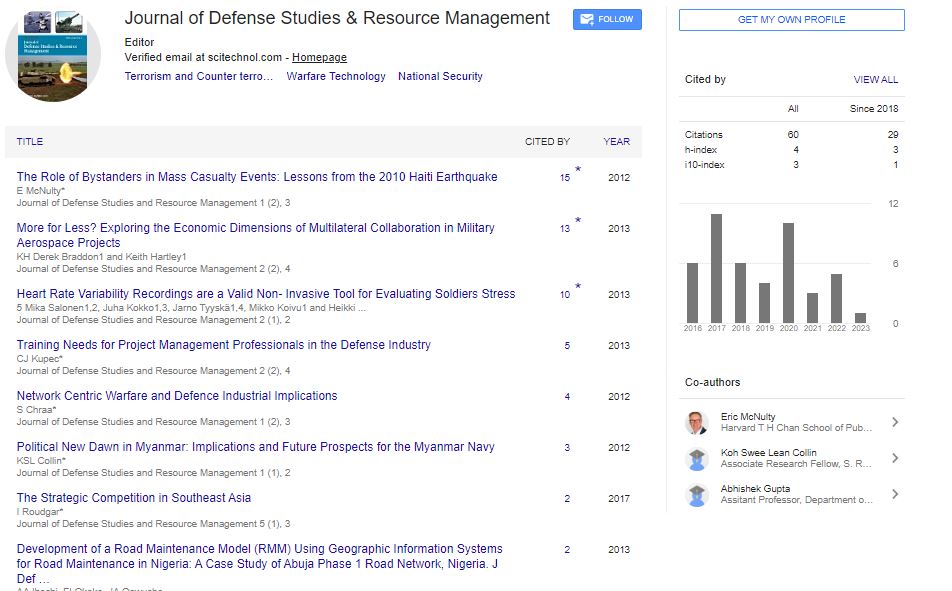Opinion Article, J Def Stud Resour Manage Vol: 11 Issue: 3
Patriot System: A Shield against the Sky Warriors
Vieira Koopmans*
1Department of Business Administration, Augustana College, United States of America
*Corresponding Author: Vieira Koopmans,
Department of Business Administration,
Augustana College, United States of America
E-mail: koopv1@augustana.edu
Received date: 30 August, 2023, Manuscript No. JDSRM-23-116465;
Editor assigned date: 01 September, 2023, PreQC No. JDSRM-23-116465 (PQ);
Reviewed date: 15 September, 2023, QC No. JDSRM-23-116465;
Revised date: 22 September, 2023, Manuscript No. JDSRM-23-116465 (R);
Published date: 02 October, 2023, DOI: 10.4172/2324-9315.1000185
Citation: Koopmans V (2023) Patriot System: A Shield against the Sky Warriors J Def Stud Resour Manage 11:3.
Abstract
In an ever-evolving landscape of global security threats, advanced technology has become the linchpin for safeguarding nations and their citizens. Among the cutting-edge innovations in military defense, the Patriot system stands as a stalwart guardian of the skies. Developed by the United States and adopted by several countries worldwide, the Patriot system is a formidable surface-to-air missile system designed to protect against a range of airborne threats, from ballistic missiles to aircraft. With its impressive capabilities and storied history, the Patriot system continues to be at the forefront of modern air defense.
Description
In an ever-evolving landscape of global security threats, advanced technology has become the linchpin for safeguarding nations and their citizens. Among the cutting-edge innovations in military defense, the Patriot system stands as a stalwart guardian of the skies. Developed by the United States and adopted by several countries worldwide, the Patriot system is a formidable surface-to-air missile system designed to protect against a range of airborne threats, from ballistic missiles to aircraft. With its impressive capabilities and storied history, the Patriot system continues to be at the forefront of modern air defense. The origins of the Patriot system can be traced back to the 1960s when the need for a comprehensive air defense system was recognized. However, it was during the Gulf War in 1991 that the Patriot system gained global recognition. Deployed to intercept and destroy Scud missiles launched by Iraq, the system demonstrated its effectiveness and garnered widespread attention. This success was a testament to its advanced radar systems, fire control units, and interceptor missiles.
The components of patriot
Radar systems: At the heart of the Patriot system lies its multifunction radar system. This sophisticated technology can detect and track incoming threats with remarkable precision. It continuously provides essential target information to the system's fire control unit, allowing for rapid threat assessment and interception calculations.
Fire control: The fire control unit is the brain of the Patriot system. It processes data from the radar, makes critical decisions about launching interceptor missiles, and calculates precise trajectories for the interceptors. This real-time guidance system ensures that threats are neutralized effectively.
Interceptor missiles: The Patriot system boasts a variety of interceptor missiles, including the Patriot Advanced Capability (PAC) missiles. These missiles are designed to intercept incoming threats by engaging them in high-speed collisions. The sheer speed and precision of these interceptors make them a formidable defense against airborne dangers.
Engagement modes: The versatility of the Patriot system is one of its defining features. It can operate in various engagement modes, such as anti-aircraft, anti-ballistic missile, and anti-cruise missile modes. This adaptability allows it to respond effectively to a wide range of threats, making it an invaluable asset in contemporary warfare scenarios.
Mobility: Patriot launchers are highly mobile, mounted on trucks that enable rapid deployment to different locations as needed. This mobility ensures that the system can be strategically positioned to provide protection where it is most required.
In the fast-paced world of military technology, the Patriot system has not remained stagnant. It has undergone numerous upgrades and iterations to address evolving threats and improve its capabilities. These upgrades have included enhanced radar systems, more advanced interceptor missiles, and improved software to optimize performance.
Conclusion
As we navigate the complex and ever-changing landscape of modern security challenges, the Patriot system remains a steadfast guardian of the skies. With its cutting-edge radar systems, versatile engagement modes, and a legacy of success in real-world conflict, it continues to be a critical component of air defense systems for nations around the world. In a world where the threats from the air continue to evolve, the Patriot system stands as a testament to human ingenuity and innovation in the pursuit of peace and security. Its enduring presence in the arsenal of military forces reflects its vital role in safeguarding the skies and protecting nations from harm. In an uncertain world, the Patriot system remains a symbol of resilience and technological prowess, ready to face the challenges of tomorrow.
 Spanish
Spanish  Chinese
Chinese  Russian
Russian  German
German  French
French  Japanese
Japanese  Portuguese
Portuguese  Hindi
Hindi 